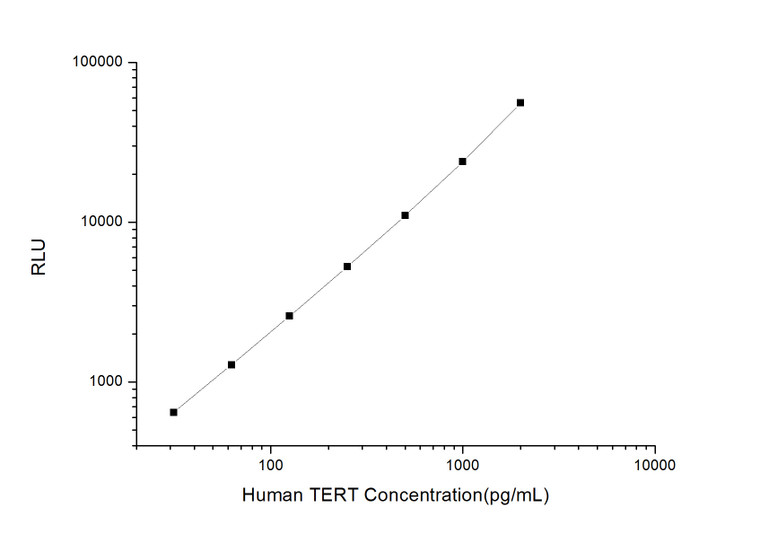| Applications: |
CLIA |
| Reactivity: |
Human |
| Note: |
FOR SCIENTIFIC EDUCATIONAL RESEARCH USE ONLY (RUO). MUST NOT BE USED IN DIAGNOSTIC OR OTHER MEDICAL APPLICATIONS. |
| Sensitivity: |
18.75pg/mL |
| Detection Limit: |
31.25~2000pg/mL |
| Short Description: |
This human TERT kit is a highly sensitive in-vitro chemiluminescent immunoassay for the measurement of trace amounts of analytes. |
| Storage Instruction: |
If unopened the kit may be stored at 2-8°C for up to 1 month. If the kit will not be used within 1 month, store the components separately, according to the component table in the manual. |
| Assay Time: |
3.5h |
| Detection: |
Chemiluminescence |
| Gene Symbol: |
TERT |
| Gene ID: |
7015 |
| Uniprot ID: |
TERT_HUMAN |
| Specificity: |
This kit recognizes Human TERT in samples. No significant cross-reactivity or interference between Human TERT and analogues was observed. |
| Sample Type: |
Serum, plasma and other biological fluids |
| Tissue Specificity | Expressed at a high level in thymocyte subpopulations, at an intermediate level in tonsil T-lymphocytes, and at a low to undetectable level in peripheral blood T-lymphocytes. |
| Post Translational Modifications | Phosphorylation at Tyr-707 under oxidative stress leads to translocation of TERT to the cytoplasm and reduces its antiapoptotic activity. Dephosphorylated by SHP2/PTPN11 leading to nuclear retention. Phosphorylation at Ser-227 by the AKT pathway promotes nuclear location. Phosphorylation at the G2/M phase at Ser-457 by DYRK2 promotes ubiquitination by the EDVP complex and degradation. Ubiquitinated by the EDVP complex, a E3 ligase complex following phosphorylation at Ser-457 by DYRK2. Ubiquitinated leads to proteasomal degradation. (Microbial infection) In case of infection by HIV-1, the EDVP complex is hijacked by HIV-1 via interaction between HIV-1 Vpr and DCAF1/VPRBP, leading to ubiquitination and degradation. |
| Function | Telomerase is a ribonucleoprotein enzyme essential for the replication of chromosome termini in most eukaryotes. Active in progenitor and cancer cells. Inactive, or very low activity, in normal somatic cells. Catalytic component of the teleromerase holoenzyme complex whose main activity is the elongation of telomeres by acting as a reverse transcriptase that adds simple sequence repeats to chromosome ends by copying a template sequence within the RNA component of the enzyme. Catalyzes the RNA-dependent extension of 3'-chromosomal termini with the 6-nucleotide telomeric repeat unit, 5'-TTAGGG-3'. The catalytic cycle involves primer binding, primer extension and release of product once the template boundary has been reached or nascent product translocation followed by further extension. More active on substrates containing 2 or 3 telomeric repeats. Telomerase activity is regulated by a number of factors including telomerase complex-associated proteins, chaperones and polypeptide modifiers. Modulates Wnt signaling. Plays important roles in aging and antiapoptosis. |
| Protein Name | Telomerase Reverse TranscriptaseHest2Telomerase Catalytic SubunitTelomerase-Associated Protein 2Tp2 |
| Database Links | Reactome: R-HSA-171319Reactome: R-HSA-201722 |
| Cellular Localisation | NucleusNucleolusNucleoplasmChromosomeTelomereCytoplasmPml BodyShuttling Between Nuclear And Cytoplasm Depends On Cell CyclePhosphorylation StatesTransformation And Dna DamageDiffuse Localization In The NucleoplasmEnriched In Nucleoli Of Certain Cell TypesTranslocated To The Cytoplasm Via Nuclear Pores In A Crm1/Ran-Dependent Manner Involving Oxidative Stress-Mediated Phosphorylation At Tyr-707Dephosphorylation At This Site By Shp2 Retains Tert In The NucleusTranslocated To The Nucleus By Phosphorylation By Akt |
| Alternative CLIA Names | Telomerase Reverse Transcriptase CLIA kitHest2 CLIA kitTelomerase Catalytic Subunit CLIA kitTelomerase-Associated Protein 2 CLIA kitTp2 CLIA kitTERT CLIA kitEST2 CLIA kitTCS1 CLIA kitTRT CLIA kit |
| Specificity | This kit recognizes Human TERT in samples. No significant cross-reactivity or interference between Human TERT and analogues was observed. |
| Reproducibility | Both intra-CV and inter-CV are |
Information sourced from Uniprot.org
| Item | Specifications | Storage |
| Micro CLIA Plate (Dismountable) | 96T: 8 wells ×12 strips strips | -20℃, 6 months |
| Reference Standard | 96T: 2 vials 48T: 1 vial | -20℃, 6 months |
| Concentrated Biotinylated Detection Ab (100×) | 96T: 1 vial, 120 μL 60 μL | -20℃, 6 months |
| Concentrated HRP Conjugate (100×) | 96T: 1 vial, 120 μL 60 μL | -20℃ (Protect from light), 6 months |
| Reference Standard & Sample Diluent | 1 vial, 20 mL | 2-8°C, 6 months |
| Biotinylated Detection Ab Diluent | 1 vial, 14 mL | 2-8°C, 6 months |
| HRP Conjugate Diluent | 1 vial, 14 mL | 2-8°C, 6 months |
| Concentrated Wash Buffer (25×) | 1 vial, 30 mL | 2-8°C, 6 months |
| Substrate Reagent A | 1 vial, 5 mL | 2-8℃ (Protect from light) |
| Substrate Reagent B | 1 vial, 5 mL | 2-8℃ (Protect from light) |
| Plate Sealer | 5 pieces | |
| Manual | 1 copy | |
| Certificate of Analysis | 1 copy | |
| Sample Type | Range (%) | Average Recovery (%) |
| Serum(n=8) | 86-100 | 92 |
| EDTA plasma(n=8) | 100-116 | 107 |
| Cell culture media(n=8) | 93-107 | 99 |
| | Intra-assay Precision | Intra-assay Precision | Intra-assay Precision | Inter-assay Precision | Inter-assay Precision | Inter-assay Precision |
| Sample | 1.00 | 2.00 | 3.00 | 1.00 | 2.00 | 3.00 |
| n | 20.00 | 20.00 | 20.00 | 20.00 | 20.00 | 20.00 |
| Mean (pg/mL) | 105.57 | 199.74 | 885.55 | 96.04 | 209.98 | 898.19 |
| Standard deviation | 13.02 | 18.06 | 70.76 | 10.25 | 21.65 | 76.26 |
| CV (%) | 12.33 | 9.04 | 7.99 | 10.67 | 10.31 | 8.49 |
12 months for antibodies. 6 months for ELISA Kits. Please see website T&Cs for further guidance







